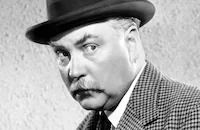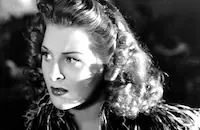The Pearl of Death
Brief Synopsis
Cast & Crew
Roy William Neill
Basil Rathbone
Nigel Bruce
Dennis Hoey
Evelyn Ankers
Miles Mander
Film Details
Technical Specs

Synopsis
Aboard a ship to Dover, James Goodram of the Royal Regent Museum, is lured away from his stateroom by the beautiful Naomi Drake so that she can steal the item he is transporting, the Borgia Pearl. Naomi conceals the stolen gem inside a camera, which she then convinces an elderly clergyman to carry through customs for her. Later, Naomi gives the camera to her boss, master criminal Giles Conover, only to discover that the pearl has been replaced by a note from the famous private detective, Sherlock Holmes, who was the clergyman in disguise. When the Borgia Pearl is later placed on display at the Royal Regent Museum, Holmes and his physician friend, Dr. John H. Watson, express concern about its safety, as Conover is still on the loose. Museum curator Francis Digby proudly demonstrates the museum's elaborate alarm system, but Holmes exposes a fatal flaw in the system when he simply turns off the electricity. Disguised as a workman, Conover overhears this and takes the opportunity to snatch the pearl while the alarm is off and escapes out a window. Conover is later captured, but as he no longer has the pearl in his possession, he is soon released by the police for lack of evidence. Soon thereafter, London is plagued by a series of murders, each victim of which is found with his back broken and surrounded by smashed china. Holmes quickly deduces that the murders are the work of the Hoxton Creeper, a member of Conover's gang thought killed during a prison escape from Devil's Island. After examining the broken bric-a-brac from the various murder scenes, Holmes and Watson discover that each victim owned a plaster bust of Napoleon. Retracing Conover's steps, Holmes and Watson learn that the criminal went into a plasterer's shop just prior to his capture. George Gelder, the plasterer, tells them that he was working on six Napoleons at that time, and Holmes quickly deduces that Conover placed the stolen pearl in one of the still-wet plaster busts. Upon learning that all the busts were sold to Amos Hodder, Holmes questions the art dealer, who tells the detective that his new assistant broke two of the busts, and that three others were purchased by the recent murder victims. Holmes quickly notices that Hodder's ledger has been altered and deduces that Naomi is his assistant in disguise. Holmes listens in on her phone conversations with Conover, thus acquiring the name of the fourth buyer, Dr. Julien Boncourt. Later, Conover and the Creeper break into the physician's home, where Holmes has disguised himself as Boncourt. After almost falling into the detective's trap, Conover gains the upper hand and orders the Creeper to search the house for the Napoleon bust. In a loud voice, Holmes states that Naomi has been arrested for murder and accuses Conover of allowing it to happen, which causes the lovestruck Creeper to turn on his boss and kill him. When the Creeper refuses to surrender to him, Holmes is then forced to kill the deformed giant. Police inspector Lestrade and his men then arrive on the scene, and Holmes breaks open the final bust and recovers the Borgia Pearl.

Director
Roy William Neill
Cast

Basil Rathbone

Nigel Bruce
Dennis Hoey

Evelyn Ankers

Miles Mander

Ian Wolfe
Charles Francis

Holmes Herbert
Richard Nugent
Mary Gordon

Rondo Hatton
J. Welsh Austin
Connie Leon
Charles Knight
Al Ferguson
Colin Kenny
Audrey Manners

Billy Bevan

Lillian Bronson
Leslie Denison
John Merkyl

Harry Cording
Eric Wilton
Harold Debecker
Arthur Mulliner
Wilson Benge
Arthur Stenning
Leland Hodgson
Crew
Howard Benedict
Bernard B. Brown
Russell A. Gausman
John B. Goodman
Ray Kessler
Joe Lapis
Virgil Miller
Bertram Millhauser
Roy William Neill
Martin Obzina
E. R. Robinson
Paul Sawtell
Melville Shyer
Ray Snyder
Vera West

Film Details
Technical Specs

Articles
The Pearl of Death
The Pearl of Death (1944) was the sixth of twelve Sherlock Holmes mysteries mounted by Universal between 1942 and 1946. Based loosely on the 1904 short story "The Adventure of the Six Napoleons" (collected in the omnibus The Return of Sherlock Holmes, for which Conan Doyle afforded the sleuth a reprieve from the heroic death he had met besting the nefarious Dr. Moriarty in "The Adventure of the Final Problem"), Bertram Millhauser's script is less concerned with overt wartime themes as had been the case with Sherlock Holmes and the Secret Weapon and Sherlock Holmes in Washington (both 1943). Crisply directed by Roy William Neill (who inherited the series from John Rawlins after Sherlock Holmes and the Voice of Terror and stayed on through to the final chapter, Dressed to Kill, 1946), the film is an enjoyable mash-up of mystery and espionage tropes (including a great deal of disguise-wearing) centered around "the Borgia Pearl," a Hope Diamond-like bagatelle that brings death to those who seek to possess it.
Basil Rathbone was paid $20,000 for his services (nearly double Nigel Bruce's salary of $12,000) and was allowed to bring an added measure of nervy nuance to his portrayal of Holmes this time out, as the master detective's sterling reputation suffers a blow when he loses possession of the Borgia Pearl to master thief Giles Conover (Miles Mander) and is menaced in the third act by Conover's spine-snapping amanuensis The Hoxton Creeper (Rondo Hatton). Roy William Neill finished shooting just two days over the allotted three-week schedule and The Pearl of Death is widely considered to be one of the better entries in the cherished if somewhat uneven series.
Back to Rondo Hatton. Hatton would soon be branded as Universal's "monster without makeup," a tasteless and heartless sobriquet that says less about the unfortunate actor's ability to craft a character than it does Universal's desperation for distinction at any cost. Afflicted with the glandular condition acromegaly, in which the pituitary gland produces an excess of growth hormone, Hatton was able to find bit work in Hollywood as a resident grotesque in such films as RKO's The Hunchback of Notre Dame (1939) and Fox's In Old Chicago (1937) and The Ox-Bow Incident (1943). Given the presence that Hatton brings to The Pearl of Death, it is an outrage that his salary amounted to just $400. At the height of his career two years later, Hatton would bring in only $3,000 as The Brute Man (1946), a variation on his Creeper character. By the time the film was in the can, however, Universal was so embarrassed by the title that the studio fobbed it off onto the "Poverty Row" outfit Producers Releasing Company. (Universal was at the time in the process of redefining itself as Universal-International and had discontinued its B-movie mill.) Sadly, well before the theatrical release of The Brute Man, which afforded him his only starring role, Rondo Hatton died of a heart attack secondary to acromegaly at the age of 51. A cult figure in death, Hatton inspired the Rondo Hatton Classic Horror Awards, given out annually for excellence in horror, science fiction and fantasy filmmaking.
Producer: Roy William Neill
Director: Roy William Neill
Screenplay: Bertram Millhauser; Sir Arthur Conan Doyle (story "The Six Napoleons")
Cinematography: Virgil Miller
Art Direction: John B. Goodman, Martin Obzina
Music: Paul Sawtell (uncredited)
Film Editing: Ray Snyder
Cast: Basil Rathbone (Sherlock Holmes), Nigel Bruce (Doctor Watson), Dennis Hoey (Lestrade), Evelyn Ankers (Naomi Drake), Miles Mander (Giles Conover), Ian Wolfe (Amos Hodder), Charles Francis (Digby), Holmes Herbert (James Goodram), Richard Nugent (Bates), Mary Gordon (Mrs. Hudson), Rondo Hatton (The Creeper).
BW-69m.
by Richard Harland Smith
Sources:
Universal Horrors: The Studio's Classic Films, 1931-1946 by Michael Brunas, John Brunas and Tom Weaver
England's Secret Weapon: The Wartime Films of Sherlock Holmes by Amanda J. Field

The Pearl of Death
Quotes
Trivia
Notes
Modern sources include Diana Beresford in the cast. For additional information on the "Sherlock Holmes" series and other films featuring the Arthur Conan Doyle characters, consult the Series Index and see the entry below for Sherlock Holmes and the Voice of Terror, and the entries for Sherlock Holmes and The Hounds of the Baskervilles in the AFI Catalog of Feature Films, 1931-40; F3.4020 and F3.2009.














